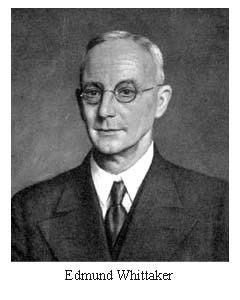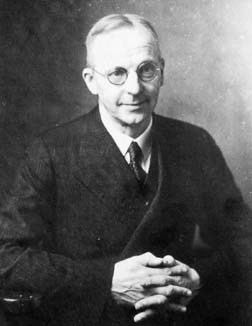Citizenship United Kingdom Role Mathematician Name E. Whittaker | Fields mathematics Nationality English | |
 | ||
Institutions University of EdinburghUniversity of Cambridge Academic advisors Andrew Russell ForsythGeorge Howard Darwin Died March 24, 1956, Edinburgh, United Kingdom Books A Course of Modern Analysis, A treatise on the analytical, A history of the theories o, The theory of optical instruments, Space and spirit Similar People G N Watson, G H Hardy, W V D Hodge, Augustus Edward Hough Lo, Bertrand Russell | ||
Children John Macnaghten Whittaker | ||
Edmund Taylor Whittaker FRS FRSE (24 October 1873 – 24 March 1956) was an English mathematician who contributed widely to applied mathematics, mathematical physics and the theory of special functions. He had a particular interest in numerical analysis, but also worked on celestial mechanics and the history of physics. Near the end of his career he received the Copley Medal, the most prestigious honorary award in British science. The School of Mathematics of the University of Edinburgh holds The Whittaker Colloquium, a yearly lecture in his honour.
Contents
- Biography
- Whittaker Watson
- Special functions
- Partial differential equations
- Special Relativity
- Works
- References

Biography
Whittaker was born in Southport, in Lancashire. He was educated at Manchester Grammar School and Trinity College, Cambridge from 1892. He graduated as Second Wrangler in the examination in 1895 and also received the Tyson Medal for Mathematics and Astronomy. In 1896, Whittaker was elected as a Fellow of Trinity College, Cambridge, and remained at Cambridge as a teacher until 1906. Between 1906 and 1911, he was the Royal Astronomer of Ireland and professor of astronomy at Trinity College Dublin where he taught mathematical physics. In 1911, Whittaker became professor at the University of Edinburgh and remained there for the rest of his career.
Shortly after coming to Edinburgh, Whittaker established a Mathematical Laboratory, the first enterprise of this kind in Great Britain, and probably one of the first attempts to make numerical analysis an integral part of the university curriculum. It is probable that in starting this new venture, Whittaker was in- fluenced by his work in astronomy, and by his friendship with the great actuaries of the period ; and to the knowledge of the present writer, he regarded the intro- duction of the Mathematical Laboratory course as his most notable contribution to mathematical education. He and his associates, among whom the most out- standing was A. C. Aitken, researched on curve fitting, numerical solution of integral equations, and similar topics ; and his thorough knowledge of the history and practice of numerical analysis found expression in his Calculus of Observations (written in collaboration with G. Robinson) which today, more than thirty years after its appearance, and after two revolutions in numerical computing, is still one of the most important works on the subject.
A classmate at Manchester Grammar School, Ernest Barker, with whom Edmund shared the office of prefect, later recalled his personality:
He had a gay, lively, bubbling spirit: he was ready for every prank: he survives in my memory as a natural actor; and I think he could also, on occasion, produce a merry poem.Whittaker was a Christian and became a convert to the Roman Catholic Church (1930). In relation to that he was a member of the Pontifical Academy of Sciences from 1936 onward and was president of a Newman Society. Earlier at Cambridge in 1901 he married the daughter of a Presbyterian minister. They had five children, including the mathematician John Macnaghten Whittaker, (1905-1984) and his elder daughter, Beatrice, married E.T. Copson, who would later become Professor of Mathematics at St. Andrews University.
Whittaker wrote the biography of a famous Italian mathematician, Vito Volterra for the Royal Society in 1941. In 1954, he was awarded the Copley Medal by the Royal Society, their highest award, "for his distinguished contributions to both pure and applied mathematics and to theoretical physics". Back in 1931 Whittaker had received the Royal Society's Sylvester Medal "for his original contributions to both pure and applied mathematics". Whittaker died in Edinburgh, Scotland.
Whittaker & Watson
Whittaker is remembered as the author of A Course of Modern Analysis (1902), which in its 1915 second edition in collaboration with George Neville Watson became Whittaker and Watson, one of the handful of mathematics texts of its era that was considered indispensable. This work has remained in print continuously for over a century.
Special functions
Whittaker is the eponym of the Whittaker function or Whittaker integral, in the theory of confluent hypergeometric functions. This makes him also the eponym of the Whittaker model in the local theory of automorphic representations. He published also on algebraic functions and automorphic functions. He gave expressions for the Bessel functions as integrals involving Legendre functions.
Partial differential equations
In the theory of partial differential equations, Whittaker developed a general solution of the Laplace equation in three dimensions and the solution of the wave equation. He developed the electrical potential field as a bi-directional flow of energy (sometimes referred to as alternating currents). Whittaker's pair of papers in 1903 and 1904 indicated that any potential can be analysed by a Fourier-like series of waves, such as a planet's gravitational field point-charge. The superpositions of inward and outward wave pairs produce the "static" fields (or scalar potential). These were harmonically-related. By this conception, the structure of electric potential is created from two opposite, though balanced, parts. Whittaker suggested that gravity possessed a wavelike "undulatory" character.
Special Relativity
In 1910, Whittaker wrote "A History of the Theories of Aether and Electricity", which gave a very detailed account of the aether theories from René Descartes to Hendrik Lorentz and Albert Einstein, including the contributions of Hermann Minkowski, and which made Whittaker a respected historian of science.
In 1951 (Vol. 1) and 1953 (Vol. 2), he published an extended and revised edition of his book in two volumes. The second volume contains some interesting historical remarks. For example, it contains a chapter named "The Relativity Theory of Poincaré and Lorentz", where Whittaker credited Henri Poincaré and Lorentz for developing special relativity,and especially alluded to Lorentz's 1904 paper (dated by Whittaker as 1903), Poincaré's St. Louis speech (The Principles of Mathematical Physics) of September 1904, and Poincaré's June 1905 paper. He attributed to Einstein's special relativity paper only little importance, which he said "set forth the relativity theory of Poincaré and Lorentz with some amplifications, and which attracted much attention”, and he credited Einstein only with being the first to publish the correct relativistic formulas for relativistic aberration and the Doppler effect. He also attributed the formula
Nevertheless, Whittaker gave a concise statement of relativity of simultaneity by referring to conjugate diameters of hyperbolas. He wrote, "[the] hyperbola is unaltered when any pair of conjugate diameters are taken as new axes, and a new unit of length is taken proportional to the length of either of these diameters." His observation means that the simultaneous events for a worldline are hyperbolic-orthogonal to the worldline.
